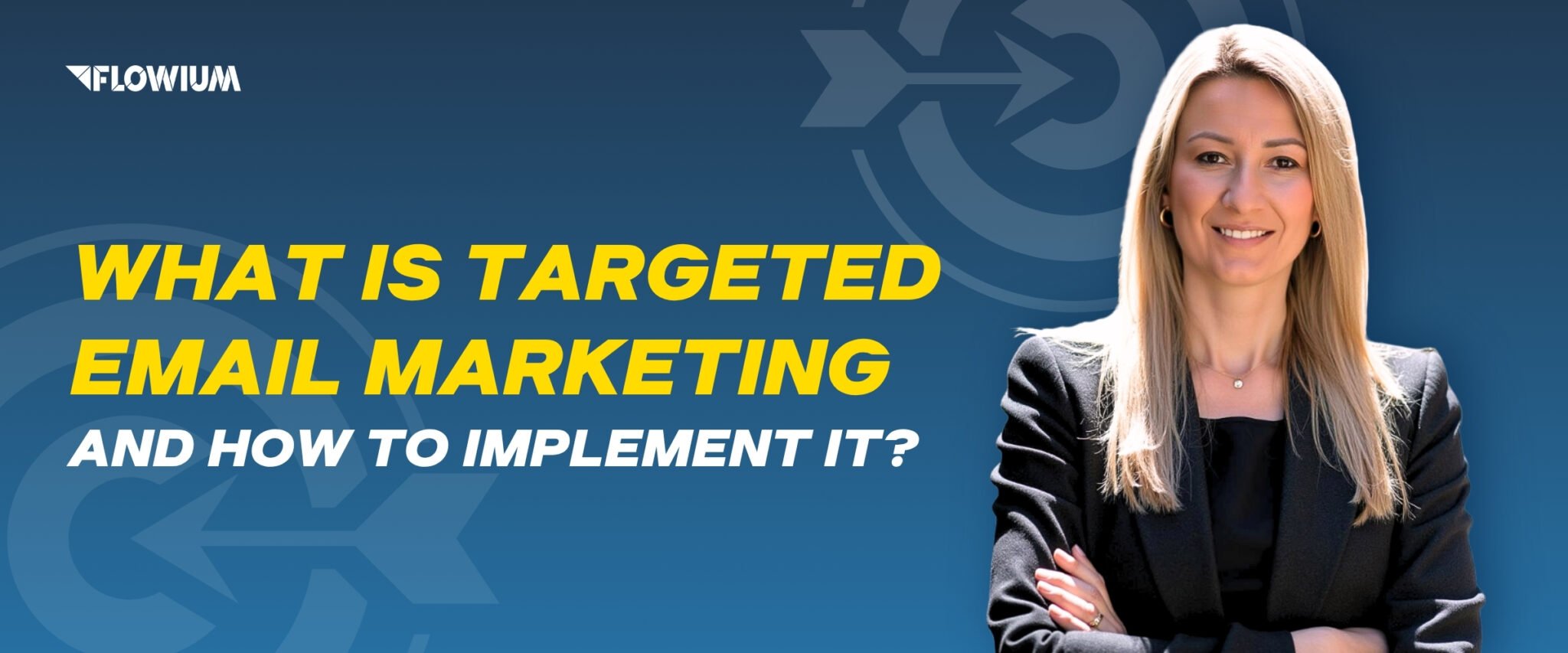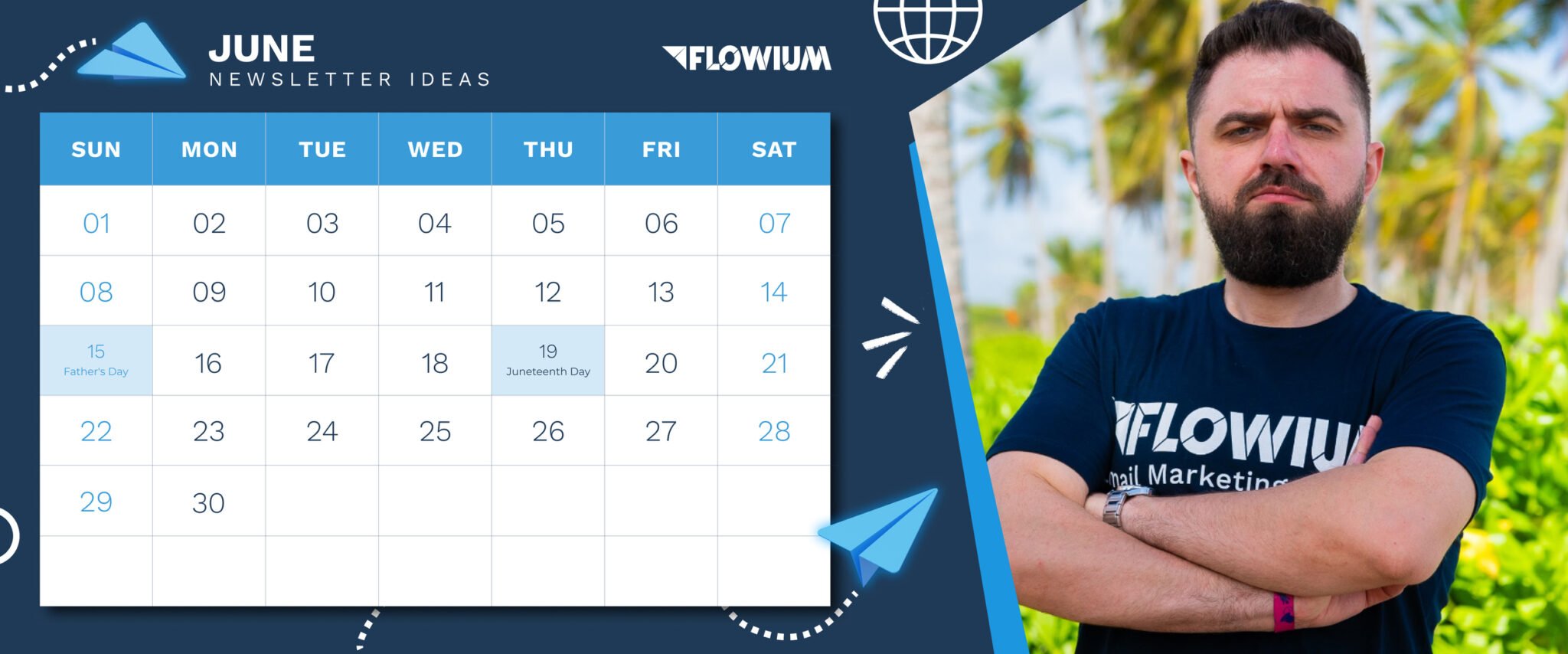Interested in getting an elusive logo next to your emails in subscribers’ inboxes? Looking for an easy way to improve such important aspects of email marketing as open rate and brand recognition? BIMI is a must-have that will take care of these aspects and solve your problem of making your emails stand out from your competitors’ emails and annoying scammers and spammers.
What is BIMI?
The abbreviation BIMI stands for Brand Indicators for Message Identification. It is an email feature that uses DKIM, SPF, and DMARC enforcement to allow official brands that have newsletter campaigns or simply communicate via email to stand out among other senders by displaying a brand logo next to the brand’s authenticated email messages.
Your official logo and verification checkmark next to the subject line is the key to your subscribers’ trust. Your subject lines will stand out from the others, and your logo will immediately identify the source of the email.
During the BIMI process, your email goes through authentication protocols, and if the authentication is successful, the email service will check your BIMI record. Once the email has a valid BIMI record, your email server will validate that record and display your logo next to the email.
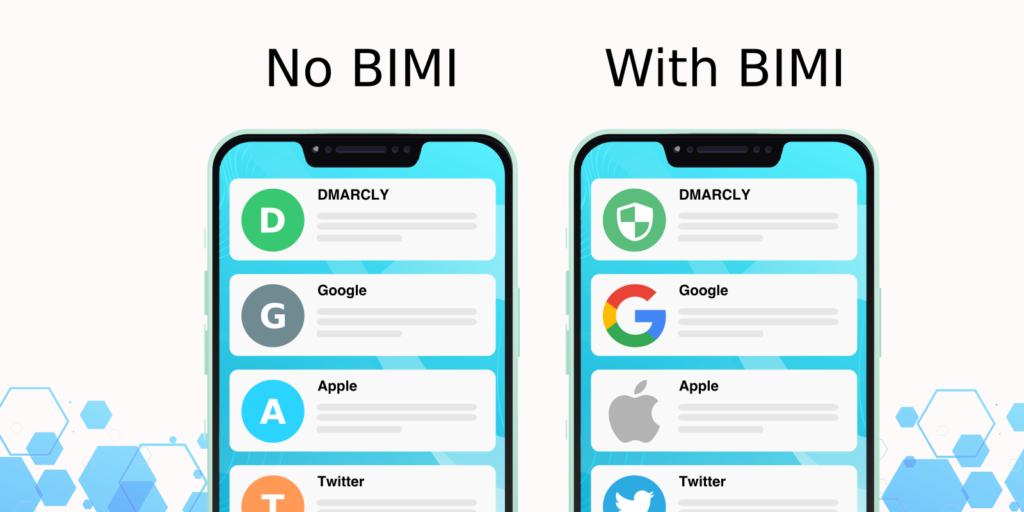
This initiative is led by the influential organization AuthIndicators Working Group, whose recognized members currently include Fastmail, Google, Mailchimp, Proofpoint, Validity, Yahoo!, Twilio SendGrid, and Valimail. The goal of this group is to develop and spread the use of BIMI to make it an integral part of the email ecosystem. This way, they will provide the perfect way to ensure brand recognition in users’ inboxes.
VMC Requirement for BIMI Email
Gmail and some other email service providers (ESPs) require a VMC (Verified Mark Certificate) as an additional verification for BIMI implementation. With a digital VMC certificate, you confirm that you have legal permission to use your brand logo for entries. In this way, your logo becomes a registered trademark.
It is necessary to ensure that branded logos are used by authorized organizations. In most cases, only with a VMC will you be able to start the BIMI process, by including the certificate in your BIMI record. Not all ESPs currently require a Verified Mark Certificate, but it is important to have it at least in cooperation with Gmail, as they are trying to implement deeper support for BIMI.
Benefits of BIMI Email Authentication for Marketers
BIMI email is valuable not only to stand out in the inbox or as a way to enhance your email marketing. It is most appreciated by senders and mailbox providers as a mean of improved security. Of course, it will also help you get noticed among empty senders and keep up with your competitors. Below, we list all the benefits that email BIMI will provide you.
- BIMI provides security updates
Email authentication in itself is already a significant advantage for any official e-commerce. Without it, every brand’s reputation is at risk. In the absence of email authentication, your domain could be spoofed and used to send spam, fraudulent emails, and dangerous phishing attempts to your subscribers. Thanks to the enforced DMARC policy, each authentication protocol you provide is your guarantee of security.
- BIMI is a protector against phishing
Speaking in more detail about data phishing through fraudulent email messages, BIMI is key for protection against such actions. The user will be able to remember the fact that emails from the official brand are marked with the official logo. If he receives an email from the same company but without the logo, he will be suspicious and will be able to avoid phishing. Therefore, one of the functions that was laid down is a trust indicator.
- Stand out from the competition
Email marketing is so widespread nowadays that any subscriber’s inbox is packed. Every email is fighting for the user’s attention to increase its open rate, and you are no exception. However, BIMI will allow you to stand out from the crowd, and what’s more, most competing emails in your subscribers’ inboxes will have an automatically generated icon instead of a brand logo. This will improve such important aspects as brand visibility, brand recognition, open rate, and user trust.
- Appearance control
With the help of BIMI, you can control how your icon appears in your subscribers’ inboxes. While previously you could control the look of your subject lines and preheaders, now you can do it with your icon. BIMI brand indicators allow you to choose the best logo, and adjust its appearance for the best look in your subscribers’ inboxes.
Providers That Support BIMI
The influence of BIMI email is also reinforced by the influential companies that already support it. Even though Microsoft mailbox providers such as Outlook and Office 365 still don’t support BIMI, its prevalence and influence are still impressive thanks to the organizations that support it. Email providers that support BIMI include: Apple, Cloudmark, Fastmail, Gmail, La Poste, Onet Poczta, Yahoo Mail, Zone, Pobox, Netscape, and Google for Business or Gsuite mailboxes.
Even if the ESP you rely on doesn’t support BIMI yet, there’s a good chance they will, as it’s a fast-growing area. Although it is currently noted that thanks to Apple’s support, BIMI is visible to 90% of users. Below we provide a list of companies that already implemented or are just considering this opportunity.
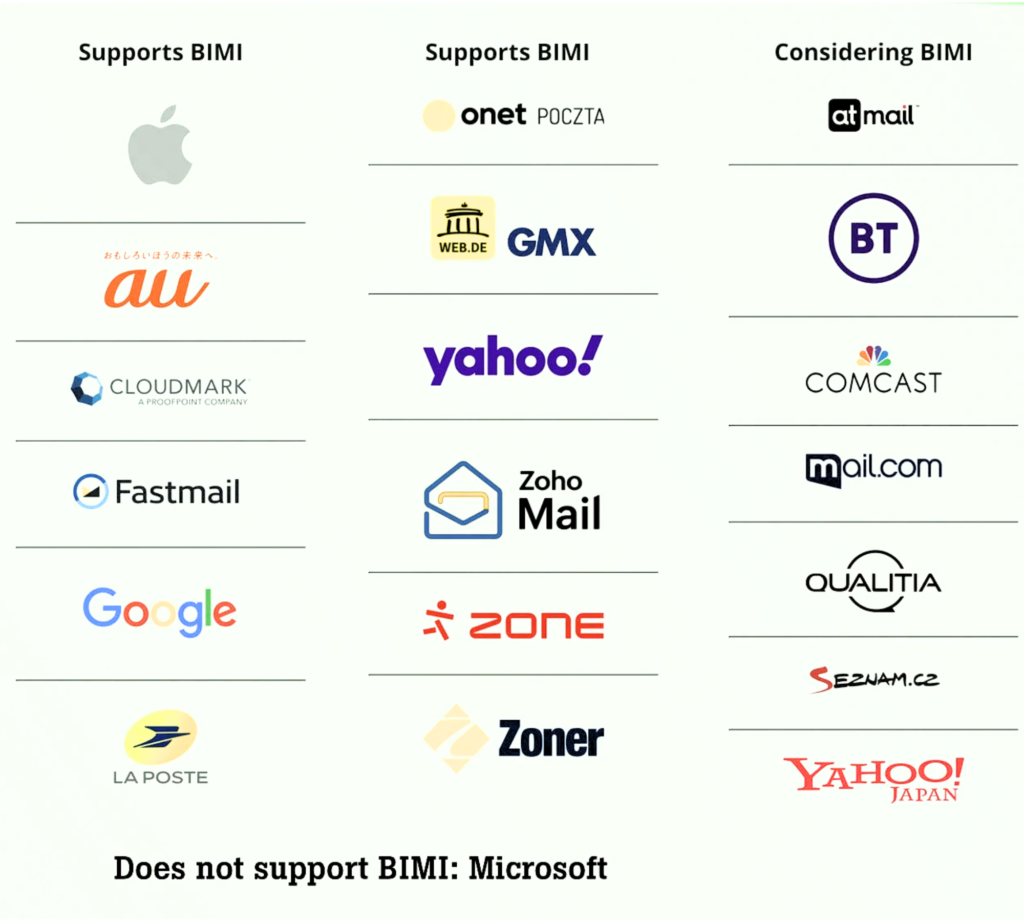
Step-by-Step Guide to Implement BIMI Email Authentication
Most guides on this issue attract with a small number of steps, but the small number of actions is caused by the lack of advanced preparation, which is equally important and requires a separate guide with a full explanation. We won’t shorten our guide to make it look easy to implement but will cover all the important external steps, as well as highlight the ones we can do for you to simplify this complicated process.
First and foremost, we need to point out that in order to achieve the appearance of your logo through authentication, you must also have high engagement with low bounces and spam complaints.
1. Getting a Trademark
Obtaining a trademark is actually an easier process than it sounds. A mandatory external step is to have an incorporated business, without which you will not be able to start moving through this guide.
To obtain a trademark, you will need to fill out an application through services such as Rocketlawyer or Fiverr, but the application will not be for the brand name, but for the logo that will be displayed in email inboxes. This process can take up to 6 months, so the sooner you start, the better. Once your trademark is approved, you can move on to step 2.
💡Pro tip: Our advice would be to go to Fiverr, and get in touch with people who will ideally be from the US and will be able to review your icon or logo and make the trademark for you.
2. Set up SPF and DMARC
To set up and correct your SPF (Sender Policy Framework), contact your hosting provider who has your DNS records set up. Your SPF may be set up but may have too many lookups included and you need to check and see if you can remove some. Without this, some emails may bounce. Ensuring that SPF, DKIM, and DMARC are correctly configured is essential to maintaining a good email reputation.
Not only should you have DMARC configured, but you should also update its policy to comply with BIMI standards. Currently, you have this DNS record:
“v=DMARC1; p=none; rua=mailto:dm***********@*******ts.com” data-original-string=”erjxESYSOzfaba35KC3feg==d1285p+B/ISd7WjcZLzL0J1E+xycg69iwi3Owammzi8qqe9MpM3cIhdeiWweWQWZCXptwE+06oshtrcvUvz4A46EQ==” title=”This contact has been encoded by Anti-Spam by CleanTalk. Click to decode. To finish the decoding make sure that JavaScript is enabled in your browser.”
You should update the p value from p=none to one of these 2 options: p=quarantine or p=reject. As a result, your DNS record should look something like this:
“v=DMARC1; p=quarantine; rua=mailto:dm***********@*******ts.com” data-original-string=”nkLfHBhSfNdpRTcdrQRYqw==d12ahnLk7HAOl4OnGWmuz9dB9fpOcWRalFKtM1U5MSk0uZEua2ImG+DCzdMrzBKec5f” title=”This contact has been encoded by Anti-Spam by CleanTalk. Click to decode. To finish the decoding make sure that JavaScript is enabled in your browser.”
The essence of these two policies is that with these values, your emails will be sent for SPF or DKIM verification first. If the verification fails, then with p=quarantine, your emails will be sent to spam, and with p=reject, they will be rejected from sending. In this way, you will present yourself as a responsible brand that is conscientious about the newsletters you are sending, enhancing your reputation.
The p=none means that recipient servers will monitor emails coming from your domain, but will not block messages that may be fraudulent, which will also interrupt the process of implementing authentication.
3. Preparing the SVG Logo File
Another troublesome step is to create an SVG file of your logo. This step will be almost impossible to do yourself using Photoshop. SVG (Scalable Vector Graphics) is a mandatory requirement for the implementation of identification. SVG is an image format that can display images at different resolutions. To apply for a VMC, you will need to provide your logo in SVG format. In addition to this format, you will need to fulfill the extra requirements listed here. To create this format, you can use any software available.
First, decide what you want to display in the subscribers’ inbox: the icon or the full logo. As an example, take a look at LinkedIn, which displays only the app icon, and Asana, which shows the full logo, making it hard to recognize in a smaller format.
Additionally, it is recommended to have a graphic designer edit your image in AI (Adobe Illustrator). The main task will be to find a designer who will edit your image according to these requirements.
Gmail Requirements for SVG Files
We will start with Gmail’s requirements for SVG files, which complement the requirements of the standard:
- The minimum image size is 96 pixels in height and width.
- The image size must be specified in absolute pixels.
- Do not use relative dimensions to specify the size of an image. Example: width=”100%” height=”100%”
- The logo must be aligned in the center.
- The background of the image should be displayed on a solid color background, a transparent background may cause problems.
- The file size should be no more than 32 KB.
- The SVG file must contain the <desc> element for accessibility.
Identification Standard Requirements for SVG Files
Here we will clarify what your logo should not contain, as well as the minimum standard requirements. The completed SVG file should not contain:
- Links, with the exception of the specified XML namespaces
- Scripts
- Interactive elements such as animations
- Attributes x= or y= in the root <svg> element
Required minimum attributes:
| SVG file attribute | Value |
|---|---|
| File format | SVG Tiny Portable/Secure (SVG Tiny PS), a version of SVG |
| baseProfile attribute | tiny-ps |
| version attribute | 1.2 |
| element | There are no strict requirements, but we recommend using a value that reflects your organization’s name |
💡 Pro tip: To simplify this process as much as possible and avoid looking for a person who can make all these numerous improvements, you can contact us, and our designers will do all the work for you.
4. Getting a BIMI Record
To obtain a BIMI record, you will need to obtain a VMC (Verified Mark Certificate), which we have already described earlier. This certificate can be provided by such companies as Entrust and Digicert. They have different annual prices from 1300 to 1500 $ per year. Yes, this opportunity is not free, and to obtain this certificate you will need to answer certain questions about your company to the organization you choose.
The main additional step for applying for verification is setting up DMARC, which we talked about in step 2. Next, you need to choose the domain you want to approve because this certificate will cover only 1 domain, additional ones will cost additional money. Here you will also need your trademark, and finally, your SVG file.
As a result, you will receive a Verified Mark certificate URL, Logo URL, and most importantly a BIMI TXT record. This BIMI TXT record is what tells Google to show your checkmark and logo when someone receives an email from your domain. In the next step, we will tell you what to do with it.
5. Adding Additional Text DNS Record
It’s also important to change your DNS to indicate your participation in authentication. The basic setting is “v=BIMI1; l=logoURL;” as a TXT record for default._bimi.yourdomain. The last step is to add a textual DNS record in your domain hosting provider, like in this example:
“v=BIMI1;l=;a=https://images.solarmora.com/brand/certificate.pem”
But replace it with the domain you got and below you can see where you should add this DNS record.
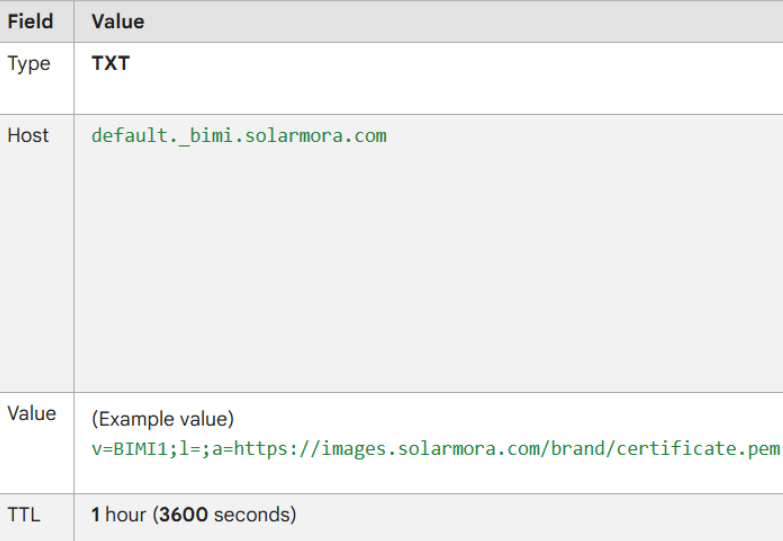
Congratulations, your implementation is now complete, you have overcome this time-consuming journey. Of course, after implementation, you would like to see what the email from you looks like now, so below we will tell you how to view the result of your work.
Alternative Ways to Get an Email Logo
Yes, you read that right, there are workarounds for displaying your logo in inboxes and more. These methods are significantly different from the implementation of authentication, they are simpler, but they leave you without many of the benefits we have presented.
Some of the logos you see in your inbox may appear there because of a combination of Google Annotations or by updating the profile picture in the Google admin account. You can use these methods to get the effect of an attractive logo, but it will not bring you the benefit of improved security.
Checking for BIMI
Once you’ve implemented BIMI, you’ll want to see what the emails in the inbox look like. In addition, most testers will also show you if you have met all the requirements and if everything is working as expected. Such testers can be:
Checking with them is easy, you just need to enter the domain. Their functions are to tell you if your implementation is ready or not, they’ll also list the BIMI record, if the logo is certified (with a VMC), and show what the logo looks like in a desktop version and mobile setting. Here are examples of how testing looks like from Valimail.
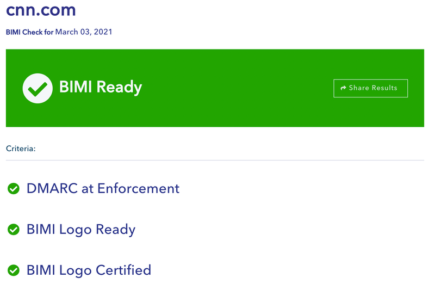
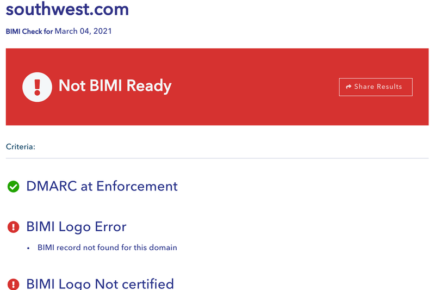
If you encounter additional implementation issues, you can check out the following resources: DMARC Digests, BIMI lookup tool, BIMI FAQ page, and SVG conversion tool.
Final Thoughts
Implementing BIMI email authentication is an indispensable thing for large businesses, and especially vital for e-commerce with email marketing. Of course, there are many free workarounds for adding a logo to your emails, but these methods will not guarantee the safety of you and your subscribers. We recommend that you implement BIMI anyway, as it will bring you many benefits that we have described in the article.
FAQ
Is BIMI supported by Outlook?
During the development of BIMI, a large number of email companies have already supported it, but Microsoft with its Outlook and Office 365 still stands aside and does not plan to implement it in its email providers.
Why are BIMI emails sent to spam?
If your emails end up in spam, it’s not because of BIMI. Most likely, it’s due to problems with email authentication. To resolve this, please review our implementation steps to make sure you’ve done everything correctly, or try one of our offered testers to see if everything is working as it should.
Does BIMI impact deliverability?
BIMI increases deliverability by improving brand visibility, brand trust, and open rates, which in turn will show mailbox providers that users want to see your emails. Since BIMI functions in conjunction with reputable software such as DMARC, DKIM, and SPF, implementing authentication will help you improve deliverability.



